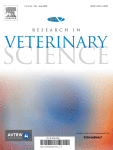Ver ítem
- xmlui.general.dspace_homeCentros Regionales y EEAsCentro Regional Santa FeEEA RafaelaArtículos científicosxmlui.ArtifactBrowser.ItemViewer.trail
- Inicio
- Centros Regionales y EEAs
- Centro Regional Santa Fe
- EEA Rafaela
- Artículos científicos
- Ver ítem
Assessment of habitat suitability for the cattle tick Rhipicephalus (Boophilus) microplus in temperate areas
Resumen
The aim of this research was to analyze and model the aptitude of temperate areas to support permanent populations of the cattle tick Rhipicephalus microplus, which is principally distributed in tropical and subtropical areas. This work integrated field-derived data of tick development with temperature and land-based models of tick spread in Argentina. The integrated analysis of the results suggest that approximately 31°S is the southern limit where R.
[ver mas...]
The aim of this research was to analyze and model the aptitude of temperate areas to support permanent populations of the cattle tick Rhipicephalus microplus, which is principally distributed in tropical and subtropical areas. This work integrated field-derived data of tick development with temperature and land-based models of tick spread in Argentina. The integrated analysis of the results suggest that approximately 31°S is the southern limit where R. microplus finds appropriate climatic conditions to be established permanently. The establishment of permanent populations of R. microplus south of this latitudinal threshold is currently restricted because the low temperatures in autumn and winter inhibit the development of its eggs, but the introduction of cattle infested with R. microplus from early spring to late summer in temperate areas could produce engorged females laying eggs that would originate viable larvae from late spring to winter. The comparison of the temperature-based maps of habitat suitability with those obtained considering the lands suitable for livestock grazing, clearly shows that the models based only on climatic variables overestimate the potential dispersal of the cattle tick. The outcomes of this study suggest that an increase of temperature in the months of autumn and winter around 2°-2.75 °C should be necessary for the establishment of permanent populations of R. micoplus in the region belonging to temperate areas. This would allow that a tick generation emerged in early spring due to the overwintering of eggs and larvae originated from females detached from cattle during autumn or early winter.
[Cerrar]

Autor
Nava, Santiago;
Gamietea, Ignacio José;
Morel, Nicolas;
Guglielmone, Alberto;
Estrada-Peña, Agustín;
Fuente
Research in Veterinary Science 150 : 10-21 (December 2022)
Fecha
2022-07
Editorial
Elsevier
ISSN
0034-5288
Documentos Relacionados
Formato
pdf
Tipo de documento
artículo
Proyectos
(ver más)
INTA/2019-PE-E5-I109-001/2019-PE-E5-I109-001/AR./Convocatoria: Estudios para el control de enfermedades subtropicales y/o transmitidas por vectores (Tristeza Bovina, Garrapatas, Miasis, Tripanosomiasis, Lengua Azul y la
Palabras Claves
Derechos de acceso
Restringido
 Excepto donde se diga explicitamente, este item se publica bajo la siguiente descripción: Creative Commons Attribution-NonCommercial-ShareAlike 2.5 Unported (CC BY-NC-SA 2.5)
Excepto donde se diga explicitamente, este item se publica bajo la siguiente descripción: Creative Commons Attribution-NonCommercial-ShareAlike 2.5 Unported (CC BY-NC-SA 2.5)

